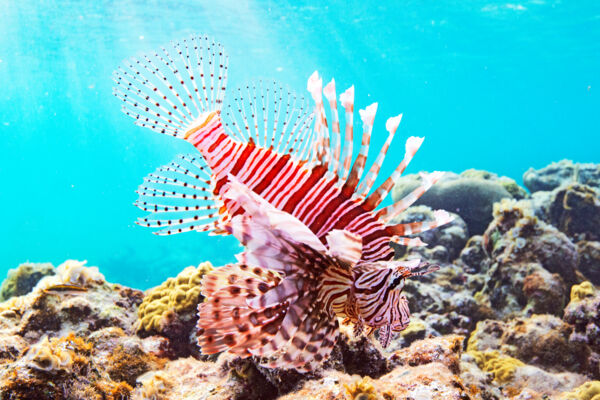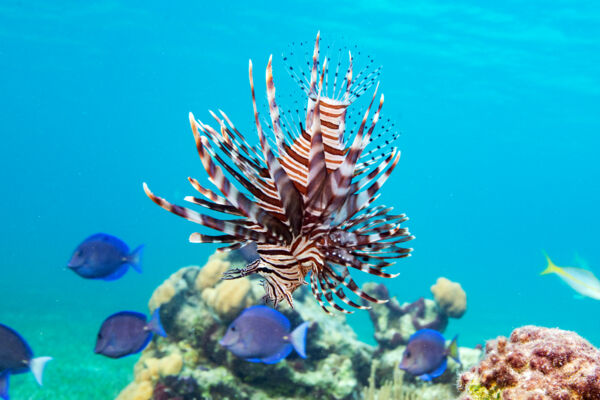Lionfish in the Turks and Caicos
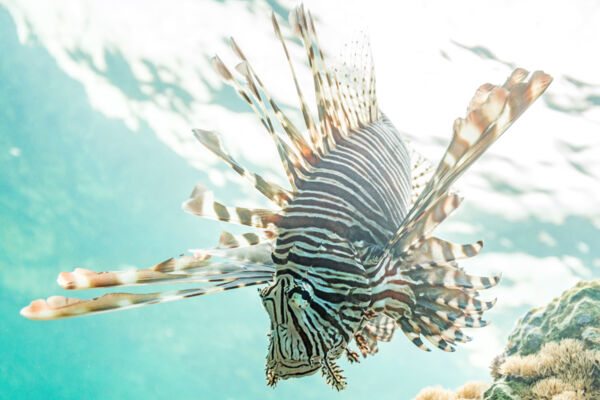
The lionfish is an invasive and venomous fish originating from the Indo-Pacific, which is now present throughout the Turks and Caicos and tropical Atlantic. It’s quite damaging to local reef ecosystems, and is found throughout a range of depths and environments. The red lionfish (Pterois volitans) is the most common type of lionfish in the Turks and Caicos.
Lionfish are the only marine species that can be legally speared recreationally in the Turks and Caicos, the only fish or marine product that can be collected in a nature reserve or national park (outside of a permitted scientific or research situation), and the only marine product that can be gathered with scuba diving equipment. They’re also great eating, with a taste and texture reminiscent of grouper.
Lionfish Fishing License
| Lionfish | |
| Common names | Lionfish Red Lionfish |
| Binomial name | Pterois volitans |
| Global conservation status | Least concern |
| Conservation status in TCI | Invasive |
| Distribution in TCI | Somewhat common |
| Maximum length | 18 inches (457 mm) |
Although the lionfish is an invasive species that the government would be happy to see eradicated, it’s necessary to obtain a license to legally harvest lionfish. This is to ensure that the reef and other species are not harmed, and that the person fishing has the necessary safety training.
Unfortunately, obtaining a lionfishing license has become difficult, to the point of being unfeasible for visitors. The reason for this change in policy is unclear, yet may be due to opaque ‘safety concerns’, or concerns of license holders spearing fish other than lionfish.
A Turks and Caicos lionfish license is valid for one year, and costs $60.
Unlike the typical recreational fishing license, lionfish licenses can only be purchased at the Department of Fisheries and Marine Resources Management office.
Fishing Methods
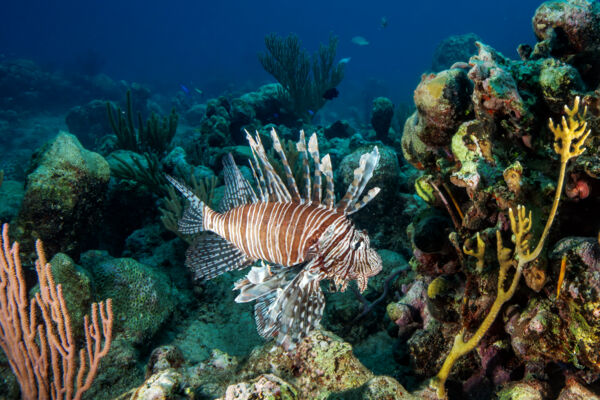
Both freediving and scuba diving for lionfish is commonly practiced in the Turks and Caicos.
The pole spear is the typical spear of choice for lionfish, and is a simple fiberglass or aluminum spear with a loop of elastic rubber at the base to launch the spear. It’s similar to a Hawaiian sling, yet is one piece and used with one hand. The spear can be held in one hand with the elastic band stretched and under tension, so the spear can be released at velocity by slightly loosening your grip.
Unlike a spear gun, a pole spear is a contained tool, and doesn’t have a projectile spear or lines to deal with.
A specialty tube or bag to safely deposit the lionfish into is also a common accessory, especially when scuba diving. Last but not least is cleaning lionfish for consumption. Generally, there are two common practices, cutting the venomous spines off before filleting the fish, or simply cutting the fillet off the intact fish. In either case, it’s best to get some instruction from someone with lionfish experience before attempting on your own. Marine EMT shears are perfect for removing the spines.
Safety
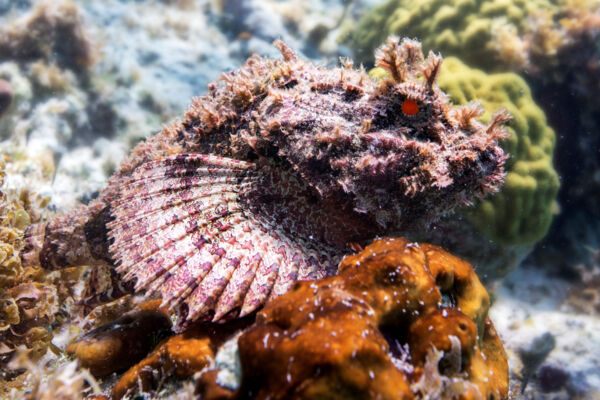
It’s important to be aware of and understand the dangers of the venomous lionfish, and the various risks of hunting for them.
Lionfish are venomous, with 18 spines capable of giving a very painful sting, which in very rare cases can cause additional complications such as temporary paralysis or breathing difficulty. The spines and corresponding stings can be easily avoided when fishing and cleaning the fish, especially with a little practice. A common treatment for a lionfish sting is to soak the afflicted area in hot water to break down the venom.
It’s also important to be aware of the many risks that are associated with freediving and scuba diving, including blackout and lung over-expansion injuries. It’s important to receive appropriate and qualified training before attempting these water sports on your own.
There are a number of creatures on the reef in the Turks and Caicos Islands that can inflict a painful sting, so it's best not to touch anything. In addition to lionfish, there are scorpionfish and several types of fire coral.
Lionfish are Great Eating
Lionfish is safe and delicious to eat. It has a very high percentage of fillet to total weight, with white flaky meat similar to grouper. It’s perfect for many methods of cooking, including sautéing, poaching, and frying.
Lionfish is an invasive species in the Turks and Caicos and is typically harvested by spearing, so eating it has a positive environmental impact, a welcome change for the local fisheries which are overfished.
The venom in lionfish poses little danger in food, especially when the lionfish is properly filleted and cooked. The venom is only located in the fish’s spines, is broken down by heat, and must enter the bloodstream to have an effect, all three factors which are easily avoided through normal preparation. Lionfish venom is completely different from the toxin in the infamous fugu pufferfish.
Fishing Locations
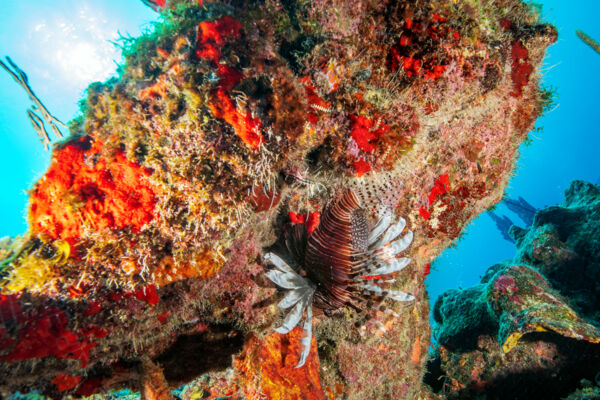
The Pterois family of fish (of which lionfish is a member) prey on smaller reef fish, so they can be found almost anywhere in the marine ecosystem. Typically, the best place to hunt is on the barrier reef and at sheltering points in the water where wrasse, damselfish, butterflyfish, and juveniles of the larger reef fish accumulate.
Lionfish typically lurk near the openings of crevices and overhangs, and don’t tend to move around much. They tend to be most active at dusk and dawn.
On Providenciales, the Bight Reef, Smith’s Reef, and the reefs at Babalua Beach and Blue Mountain all have the occasional lionfish, and are easy to access from the beach.
When fishing by boat, the entire Caicos barrier reef and wall is viable lionfish territory.
The Negative Impact of Lionfish in the Atlantic
Lionfish are known to cause a significant and lasting negative impact on reefs in the tropical Atlantic. Due to their ferocious appetite for fish, lionfish can eradicate entire subsets of existing localized food chains, ultimately causing long-term reef deterioration.
It’s thought that lionfish were introduced into the tropical Atlantic sometime in the 1980s or 1970s, probably from an aquarium breach or as discarded pets. In any case, lionfish populations in the Atlantic have exploded, and they’re now found throughout the Caribbean, Florida, and the Gulf of Mexico.
Many countries in the warmer Atlantic waters are now attempting to control lionfish populations, largely through encouraging recreational fishing of and the consumption of the fish.

